Resellos on sábanas - Central Mexico (Durango, Tepic, Zacatecas, Aguascalientes)
Canatlán – Juzgado Municipal
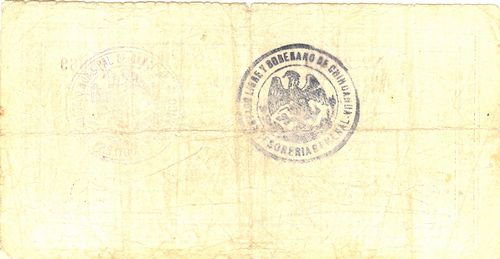
 A round (40mm) violet stamp with ‘JUZGADO MUNICIPAL DE CANATLAN - PARTIDO DE DURANGO’ and eagle in centre.
A round (40mm) violet stamp with ‘JUZGADO MUNICIPAL DE CANATLAN - PARTIDO DE DURANGO’ and eagle in centre.
Canatlán is about 40 kilometres north of Durango.
Mapimí – Presidencia Municipal

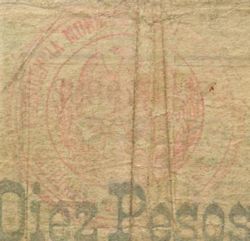 Mapimí is situated about 35 kilometres northwest of Torreón.
Mapimí is situated about 35 kilometres northwest of Torreón.
This was another office mentioned by Governor Saravia in December 1914ADUR, Sección de Hacienda, p213 telegram from Saravia to Jefe Municipal, Tepahuanes, 9 December 1914.
One revalidated note has the handwritten comment 'Circulacion forzoza. arts 5o, 6o and 7o Ley de 26 de abril de 1913', referring to Carranza's decree establishing the Monclova issue.
Durango – Dirección General de Rentas

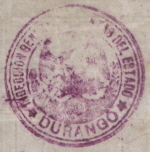 A large (40mm) round plain rubber stamp with legend ‘DIRECCION GENERAL DE RENTAS DEL ESTADO – DURANGO’ and eagle in centre, known in violet and blue ink.
A large (40mm) round plain rubber stamp with legend ‘DIRECCION GENERAL DE RENTAS DEL ESTADO – DURANGO’ and eagle in centre, known in violet and blue ink.
Durango is the capital of the state of the same name. It was one of the early successes of the rebels, being stormed and sacked by troops under Tomás Urbina in June 1913. Pastor Rouaix was elected Provisional Governor on 1 July 1913 and named Manuel del Real A. Director General de Rentas. The state issued its own paper currency from August 1913 onwards.
The sábanas will have quickly reached Durango and Carranza’s decree núm. 21 of 28 February 1914 enforcing, inter alia, the Constitucionalist notes of Chihuahua was published in Durango on 8 MarchPeriódico Oficial, 8 March 1914.
In July 1914 it was reported that Carranza had ordered federal offices not to accept notes issued by Villa in Chihuahua. As a large amount of this money had been circulating without any difficulty this naturally caused great panic but luckily it was quickly rescinded as on 15 July Carranza, from Monterrey, told Rouaix that he had already ordered the offices to accept Chihuahua notesEl Demócrata, Segunda Época, Tomo II, Núm.129, 17 July 1914.
By November 1914 there were a great number of notes in Durango that everyone was refusing to accept because they lacked resellos. Governor Emiliano G. Saravia therefore sent the Director General de Rentas to Torreón to see how he could sort out the problem. The Director brought with him two thousand pesos but the official sent from Torreón rejected half of them. Saravia made the valid point that if such an official, acting in complete knowledge and with total impartiality, could find half the notes bogus it was obvious that the general public would refuse to accept anyADUR, Sección de Hacienda p178, telegram Saravia to Villa, 17 November 1914. Action was needed to instil confidence and on 23 November R. Mendarózqueta, the Oficial Mayor Interino, sent a circular telegram to the Jefes Politicos of Indé, Ciudad Lerdo, Topia, Papasquiaro, el Oro, Nazas, San Juan del Río, San Juan de Guadalupe, San Dimas, Nombre de Dios, Mezquital, Gómez Palacio, Tepehuanes, Guanaceví, Canatlán and Cuencamé that the bonos needed to be sent to the government to be revalidated (para resellarlos)ADUR, Libro Copiador 278, Telegramas 13 August 1914 - 23 April 1915, pp. 189-191 and Fondo Secretaria General de Gobierno (Siglo XX), Sección 6 Gobierno, Serie 6.7 Correspondencia, caja 7, nombre 57. Telegrams record $450 in notes sent by the Recaudador de Contribuciones of Cuencamé (30 November 1914) and $200 by the Recaudación of San Juan de Guadalupe to the Dirección General. The same day the Jefe de Armas in Nazas was told to stop people accepting bonos that had not been restampedADUR, Sección de Hacienda p197.
On 9 December the Jefe Municipal of Tepehuanes was told that only the bonos with the resello of the Direccion General de Rentas and those revalidated by the Oficinas of Chihuahua, Parral, Torreón and Mapimí were of forced circulationADUR, Libro Copiador 278, Telegramas 13 August 1914 - 23 April 1915, p213.
Durango – Jefatura de Hacienda
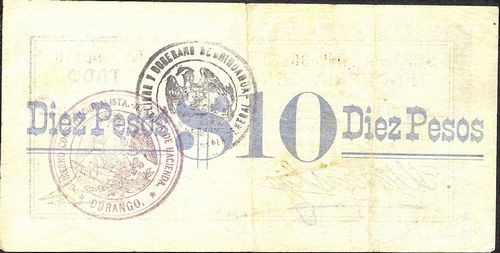
 A large (45mm) round purple stamp with ‘GOBIERNO CONSTITUCIONALISTA - JEFATURA DE HACIENDA – DURANGO’ and eagle in centre.
A large (45mm) round purple stamp with ‘GOBIERNO CONSTITUCIONALISTA - JEFATURA DE HACIENDA – DURANGO’ and eagle in centre.
However, possibly as a consequence of the Convention’s decree of 23 January 1915, the Jefatura de Hacienda in Durango was operating its own scheme. On 24 February 1915 Ygnacio Montemayor, the Jefe de Hacienda reported to the governor that he had received a reply from the Oficina de Hacienda y Fomento in Chihuahua that listed the notes that were of forced circulation. Of these, only the Gobierno Provisional de México dated 28 September and 20 October 1914 needed to be revalidated. If the public insisted that every type of note needed to be revalidated, this should be done with the Jefatura stamp (el sello de esa Oficina) though they should be aware that Chihuahua believed that this could prejudiced the holders because if they left the state, the notes might not be accepted elsewhereADUR,, gaveta 6, nombre 88.
In March 1915 some notes that had been restamped by the Dirección General de Rentas, on being paid into the Jefatura de Hacienda, were found to be counterfeit and consequently perforated. The government asked that in future they should be returned, unmarked, to the Dirección General since it was better that the latter office should exchange them at its own cost rather than that the public lose confidence in the government’s reselloADUR, Sección de Hacienda p427.
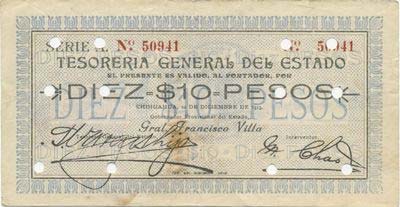
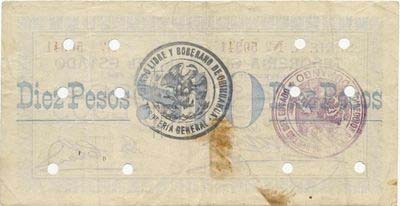
$10 sábanas with Dirección General resello but perforated as counterfeit
Durango – Administración Principal del Timbre
Two different seals are known (?).
A round (27mm) violet seal with ‘Administracion Principal del Timbre, Durango’
and
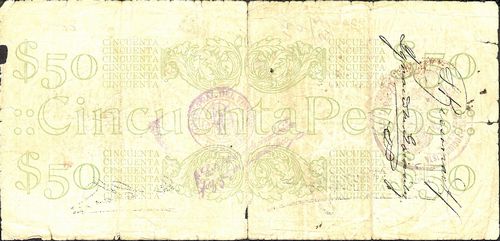
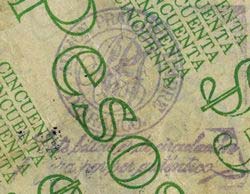 a round 27mm seal with ‘ADMON. PRAL. DEL TIMBRE – DURANGO’ with ‘Este billete es de circulacion forzosa por ser autentico’ in two lines below
a round 27mm seal with ‘ADMON. PRAL. DEL TIMBRE – DURANGO’ with ‘Este billete es de circulacion forzosa por ser autentico’ in two lines below
This resello was also possibly consequent on the Convention decree of decree of 23 January 1915Leon Aillaud was named Administrador Principal de la Renta del Timbre on 16 February 1914 (La Union Liberal, 16 February 1914). L. J. Zalce was Administrador Principal del Timbre on 1 June 1914 and was in use by March 1915 since on 8 March Villa informed the Jefe de Hacienda that he had ordered the authorities to continue checking and restamping all Chihuahuan notes in the Administración del TimbreVida Nueva, 9 March 1915: Prensa, 14 March 1915: ADUR, gaveta 6, nombre 88 letter Jefe de Hacienda Ignacio Montemayor to governor Saravia 8 March 1915: mentions just sábanas.
Durango was recaptured by General Domingo Arrieta on 12 August 1915.
Tepic – Jefatura Política
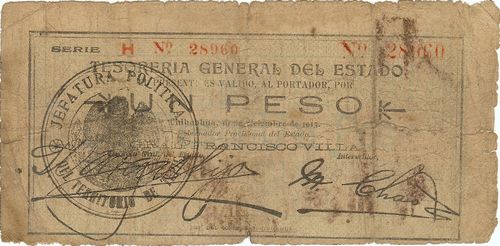
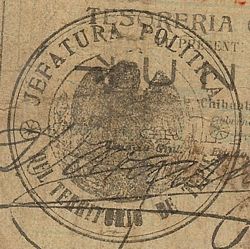 Two different resellos are known from this office. Type 1 is a round 43mm rubber stamp with legend ‘JEFATURA POLITICA DEL TERRITORIO DE TEPIC’ with eagle in centre, known in black.
Two different resellos are known from this office. Type 1 is a round 43mm rubber stamp with legend ‘JEFATURA POLITICA DEL TERRITORIO DE TEPIC’ with eagle in centre, known in black.
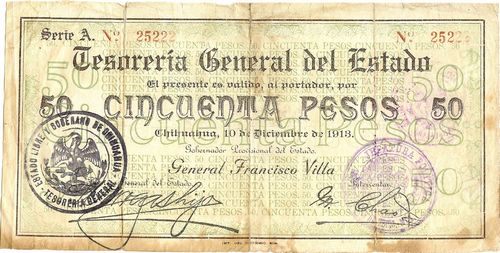
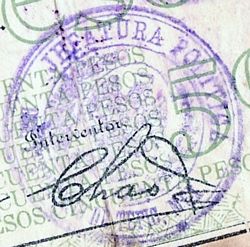 Type 2 is a smaller (38mm) circular stamp with legend 'JEFATURA POLITICA DEL TERRITORIO DE TEPIC, MEX.' with eagle, known in violet.
Type 2 is a smaller (38mm) circular stamp with legend 'JEFATURA POLITICA DEL TERRITORIO DE TEPIC, MEX.' with eagle, known in violet.
Tepic is the capital and largest city of the present state of Nayarit, about 225 kilometres north-west of Guadalajara. It was captured by the revolutionaries in mid-May 1914.
Zacatecas – [ ]
As stated elsewhere, the Zacatecas experts may have used a Tesorería General de Chihuahua resello. On 4 January 1915 the Zacatecas paper, Siglo XX, reported that the revalidation being applied to genuine Chihuahua notes was blue, the same colour as applied to the words that cancelled the counterfeit notes. One in ten notes were turning out false. The State government and the Jefatura de Hacienda were trying to arrange a consignment of $200,000 in dos caritas to begin the exchange of the notes being revalidated and to retire those in poor conditionSiglo XX, 4 January 1915.
In reply to a query from various businesses, whether notes that had the signatures or seals of Jefaturas and Jefes de Armas of other places still need the resello of the Chihuahua Treasury, Gregorio R. Rivera, who had been sent from Chihuahua to check notes (Enviado de la Tesorería del Estado de Chihuahua) answered that they should be revalidated, since these did not have the facility and were directly responsible for any revalidation they made. The state of Chihuahua only recognised the notes validated by its Treasury or its legally authorised representativesSiglo XX, 8 January 1915.
By 13 January Rivera had received enough dos caritas and from the following day he was going to begin to exchange sábanas with dos caritasSiglo XX, 13 January 1915.
Zacatecas – Jefatura de Hacienda
This resello is mentioned but possibly did not exist. On 22 January Teodoro Carillo, the Jefe de Hacienda in Zacatecas, issued a circular that stated, inter alia, that the sábanas should be accepted, as they were only exchanging the ones in poor condition and were revalidating the higher values ($5, $10, $20, $50 and $100)Siglo XX, 22 January 1915. On 26 April 1915 the Director General de Rentas in Zacatecas told the state government that in future the Oficinas Rentísticas would only accept the 25c, 50c and $1 sábanas if they had the resello of the Zacatecas Jefatura de Hacienda, and that offices should send in to the Dirección General any notes that lacked this requirement so that they could be revalidated. This was copied to the various municipios on 29 April AMZ, caja 14, exp 4. folio 184. However, low-value sábanas were not usually revalidated, and Zacatecas was captured by the Carrancistas on 17 July.
Concepción del Oro – Recaudación de Rentas
 ‘RECAUDACION DE RENTAS – CONCEPCION DEL ORO, ZAC.’ with handwritten ‘Se resella por orden del Sr. Gral. M. Ramos / J. G Garcia’.
‘RECAUDACION DE RENTAS – CONCEPCION DEL ORO, ZAC.’ with handwritten ‘Se resella por orden del Sr. Gral. M. Ramos / J. G Garcia’.
Concepción del Oro is about 80 kilometres south of Saltillo on the main road to Zacatecas.
General Matías Ramos Santos was born in 1891 and was originally a farmer and then a miner in his native state of Zacatecas. In 1911 he joined the revolution under the command of General Gertrudis G. Sánchez and took part in many actions. He remained loyal to Carranza and after the revolution served in a variety of posts, including governor of Zacatecas and Secretary of Defence. He died in 1962.
Aguascalientes – Secretaria de Gobierno
 A round violet ‘Secretaria de Gobierno – Aguascalientes’ with eagle in centre.
A round violet ‘Secretaria de Gobierno – Aguascalientes’ with eagle in centre.
Aguascalientes is the capital of the state of the same name, and was captured by the Constitutionalists on 22 July 1914. In the first half of 1915 it was one of the areas disputed by Villa’s División del Norte and Obregón’s Ejército de Operaciones and the economy deteriorated as a consequence.
On 20 February 1915 an office was set up in the Tesorería General del Estado to restamp all sábanas, except those of one peso or lessPeriódico Oficial, 22 February 1915. Six days later another office was established in the branch of the Banco de Zacatecas, avenida Juárez, to exchange the sábanas for dos caritasPeriódico Oficial, 27 February 1915.
Obregón took Aguascalientes from Villa during the middle of July 1915.
